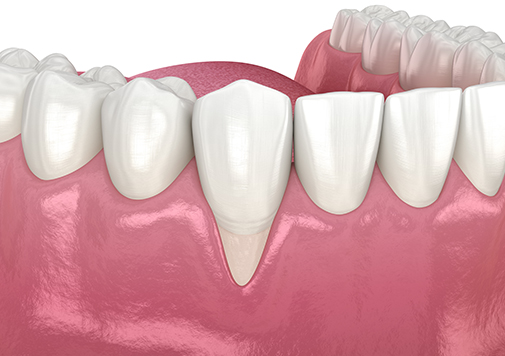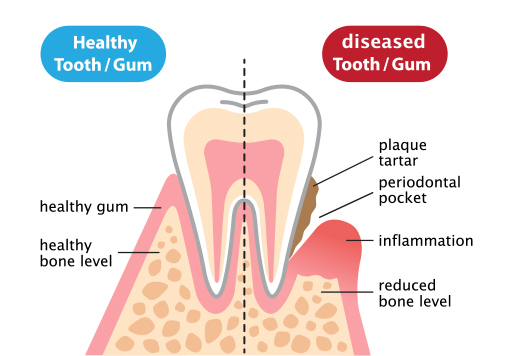
Gingivitis is a common and mild form of gum disease of your gums
Gingivitis means inflammation of the gum usually caused by bacterial infection.
If left untreated, Gingivitis or gum inflammation can become a serious periodontal disease known as periodontitis. When plaque accumulates in between your teeth, it causes gum inflammation. However, gum recession sets in only in the later stages of periodontal disease. Gingivitis should be taken as a warning and should be taken as a sign to be more proactive about your oral hygiene routine. Periodontitis occurs when gingivitis is left untreated and the patient would be required to visit a periodontist in Dubai. Once periodontitis sets in, the space in between the teeth, gum and the bone increases. The spaces are called periodontal pockets and they get filled with harmful bacteria. Soon, the plaque spreads and grows below the gumline, which can lead to tooth and bone loss. In such a situation, it recommended that one avail periodontitis treatment in Dubai on a timely basis.
More
Gingivitis does not have any irreversible bone damage. At Dr Paul’s, we provide gingivitis treatment in Dubai. We recommend that you visit our gum specialist in Dubai for a routine dental cleaning if you have been diagnosed with gingivitis. Our periodontist will remove the plaque and tartar to restore your oral health.
Less

Gingivitis is in fact, one of the mildest forms of gum disease. But if it is left untreated for a long time, gingivitis can advance to periodontitis.
At our clinic in Dubai, our periodontist dentists adopt the following gingivitis treatment procedure:
More
Plaque and tartar are removed from above and below the gum line of all teeth. Scaling acts as a preventive measure and helps the gums to be healthy.
The non-surgical procedure involves two steps: scaling and root planing. Scaling is done under a local anesthetic gel, the plaque and tartar are removed from above and below the gum line. Planing involves smoothening of rough spots on the tooth root surface. Scaling and root planing removes bacteria and provides a clean surface for the gums to reattach to the teeth.
Diseased gum tissues are debrided and tartar on the root surface is removed. In some cases irregular surfaces of the damaged bone are smoothened to limit areas where disease-causing bacteria can hide. Gums are sutured, so that the tissue fits properly around the teeth. This method reduces the periodontal pockets making it easier for the patient to keep the area clean.
This procedure involves using fragments of own bone, synthetic bone, donor bone to replace bone destroyed by gum disease. These new bone grafts will act as the platform for the new bone growth which will add stability to your teeth.
Reinforces thin gums or fills in places where gums have receded. Soft tissue gum grafts allow bone stimulation and the regeneration of gum tissue when the bone around your teeth is damaged.
Performed when the bone supporting your teeth has been destroyed, this procedure stimulates the bone to regenerate and gum tissue to grow.
The bone around the tooth is reshaped to decrease the craters. This makes it hard for the bacteria to collect and grow. Bone surgery allows to smoothens shallow craters in the bony defect due to periodontal disease
LANAP uses laser technology to remove disease tissue and bacteria from the affected areas while maintaining the height of the gum tissue. LANAP is the only procedure which allows your gums and bone to regenerate.
Less

The reasons are as under:
Here are the three ways to ward off gum diseases - brushing your teeth, flossing daily and visiting your dentist twice a year. It is important to visit your dentist as most people never suspect they have gum disease. People often have the wrong notion that if you brush and floss regularly, you cannot get gum disease. It is important to visit your dentist at least twice a year as some causes of gum disease are not directly connected to oral hygiene.
Bleeding gums, swollen and red gums, bad breath, looseness of teeth and discharges from gums, spacing between teeth, a burning sensation in the gums and pain in the gums are the indications of gum disease.
Gum disease or periodontal disease is the primary cause of tooth loss. Research also reveals that it increases your risk for: